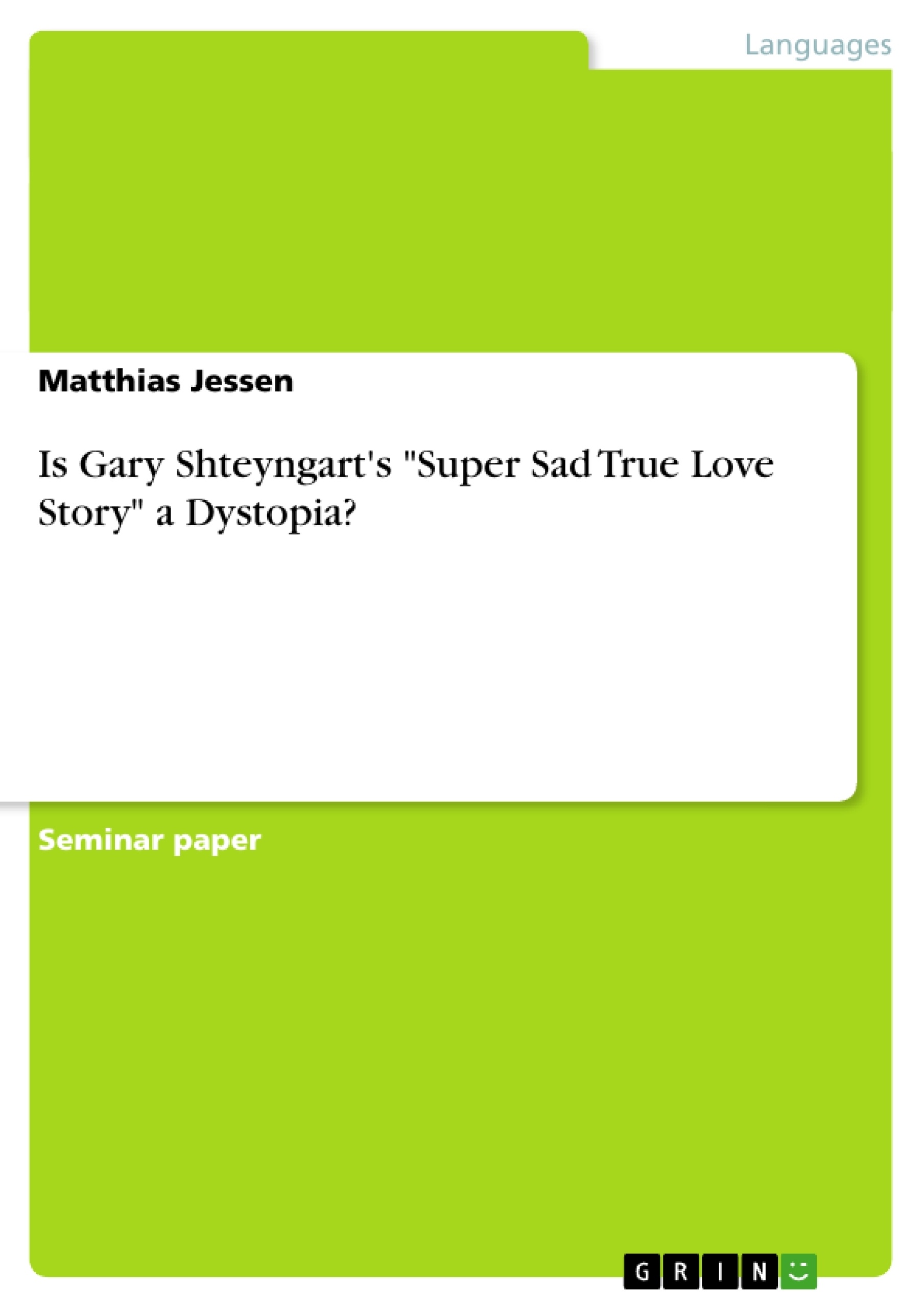In dieser Hausarbeit wird untersucht, ob der Roman von Gary Shteyngart die formalen Kriterien einer dystopischen Erzählung erfüllt. Als Vergleich werden einschlägige Werke von George Orwell, Ray Bradbury, H.G. Wells und Aldous Huxley herangezogen.
Table of Contents
- Introduction
- Dystopian Literature: A Historical Overview
- Characteristics of the Classic Dystopia
- The Function and Intention of Dystopian Literature
- Super Sad True Love Story: A Dystopian Vision of the USA
Objectives and Key Themes
This paper aims to analyze Gary Shteyngart's Super Sad True Love Story as a dystopian novel, examining its place within the tradition of dystopian literature and its commentary on contemporary societal trends. The analysis explores the novel's portrayal of a future United States facing political, economic, and social crises.
- The characteristics of dystopian literature and how Super Sad True Love Story fits within this tradition.
- The novel's critique of American society and its potential future trajectory.
- The role of technology and media in shaping and controlling individuals and society.
- The exploration of themes of materialism, consumerism, and the loss of personal identity.
- The consequences of unchecked political and economic power.
Chapter Summaries
Introduction: This introductory section provides background information on Gary Shteyngart's Super Sad True Love Story, establishing it as a dystopian novel and briefly mentioning other prominent works in the genre. It sets the stage for a deeper examination of the novel's themes and techniques.
Dystopian Literature: A Historical Overview: This chapter traces the history of dystopian literature, highlighting key works and authors such as Yevgeny Zamyatin (We), Aldous Huxley (Brave New World), and George Orwell (Nineteen Eighty-Four). It discusses the evolution of the dystopian genre and its recurring themes of totalitarian control, societal collapse, and technological dehumanization. The chapter explores the genre's origins in societal anxieties and its function as social commentary.
Characteristics of the Classic Dystopia: This chapter outlines the defining features of classic dystopian novels, including elements such as totalitarian regimes, suppression of individual freedom, control of language and media, and the isolation of individuals. It also discusses the use of artifacts from the past as reminders of lost freedoms and possibilities. The chapter serves as a framework for analyzing Super Sad True Love Story's adherence to, or deviation from, these conventions.
The Function and Intention of Dystopian Literature: This chapter explores the purpose and social impact of dystopian literature. It considers the genre’s role as social criticism, offering a warning about potential negative societal trajectories. The chapter explores the idea that dystopian novels serve as "intellectual eye-openers," prompting readers to critically examine present-day trends and their possible consequences. The discussion highlights the dystopia's capacity not only to warn but also to challenge readers' assumptions about the status quo.
Super Sad True Love Story: A Dystopian Vision of the USA: This chapter provides a detailed analysis of Shteyngart's novel, focusing on its depiction of a future America in crisis. It explores the novel's portrayal of political, economic, and social decay, highlighting the themes of materialism, the pervasiveness of technology and mass media, and the erosion of individual identity. The analysis details how the novel uses satire and exaggeration to comment on contemporary trends and warn of potential negative futures. The chapter will incorporate specific examples from the text to support its analysis.
Keywords
Dystopian literature, Gary Shteyngart, Super Sad True Love Story, social commentary, technological control, American society, consumerism, materialism, political satire, future studies, dystopia, anti-utopia, social criticism.
Super Sad True Love Story: A Dystopian Analysis - FAQ
What is the main focus of this analysis?
This analysis focuses on Gary Shteyngart's Super Sad True Love Story as a dystopian novel. It examines the novel's place within the tradition of dystopian literature and its commentary on contemporary societal trends, particularly in the United States.
What topics are covered in the analysis?
The analysis explores several key themes including: the characteristics of dystopian literature and how Super Sad True Love Story fits within this tradition; the novel's critique of American society and its potential future; the role of technology and media in shaping and controlling individuals and society; the exploration of materialism, consumerism, and the loss of personal identity; and the consequences of unchecked political and economic power.
What is the structure of the analysis?
The analysis is structured into five chapters: an introduction providing background on the novel and its context within dystopian literature; a historical overview of dystopian literature; a discussion of the characteristics of classic dystopian novels; an exploration of the function and intention of dystopian literature; and finally, a detailed analysis of Super Sad True Love Story itself.
What are some key works of dystopian literature mentioned in the analysis?
The analysis references several influential works of dystopian literature, including Yevgeny Zamyatin's We, Aldous Huxley's Brave New World, and George Orwell's Nineteen Eighty-Four, using them to provide context and comparison for Shteyngart's novel.
What are the key themes explored in Super Sad True Love Story according to this analysis?
The analysis highlights themes of materialism, consumerism, the pervasive influence of technology and mass media, the erosion of individual identity, and the consequences of unchecked political and economic power as central to Shteyngart's dystopian vision of a future America.
What is the overall purpose of the analysis?
The analysis aims to provide a structured and professional examination of Super Sad True Love Story within the broader context of dystopian literature. It seeks to understand the novel's commentary on contemporary society and its potential warnings about future societal trajectories.
What are some key words associated with this analysis?
Key words associated with this analysis include: Dystopian literature, Gary Shteyngart, Super Sad True Love Story, social commentary, technological control, American society, consumerism, materialism, political satire, future studies, dystopia, anti-utopia, and social criticism.
What kind of analysis is this?
This is a literary analysis focusing on the dystopian aspects of Gary Shteyngart's Super Sad True Love Story, employing a structured approach to explore its themes and place within the history of the genre.
Is this analysis suitable for academic use?
Yes, this analysis is explicitly intended for academic use, providing a structured and in-depth examination of Super Sad True Love Story within the context of dystopian literature.
- Citar trabajo
- Matthias Jessen (Autor), 2012, Is Gary Shteyngart's "Super Sad True Love Story" a Dystopia?, Múnich, GRIN Verlag, https://www.grin.com/document/273749




